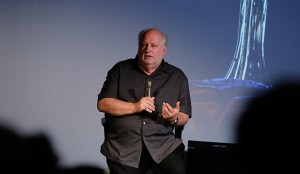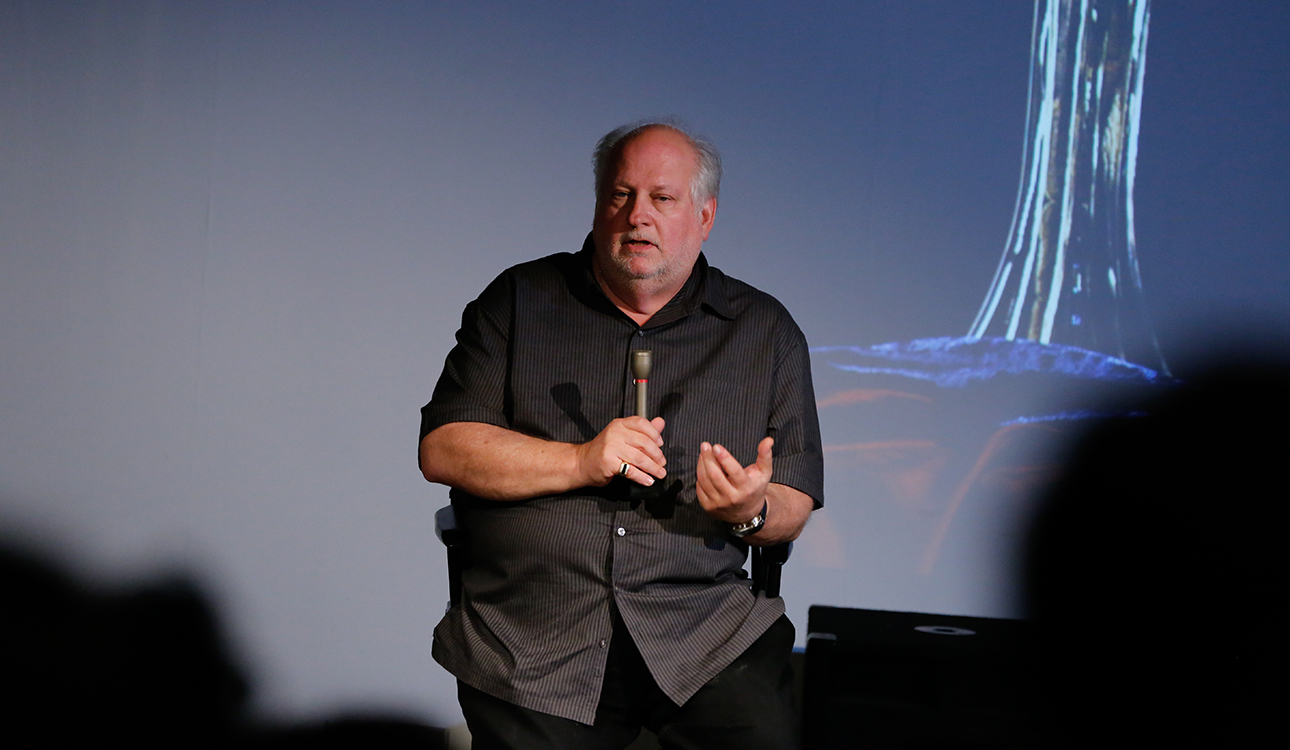
Richard Hirst | Lariat Multimedia Editor
By Julia Eckardt & Madi Miller
Reporters
Alan Gitlin, one of Hollywood’s most in demand digital imaging technicians gave a presentation to Baylor’s student chapter of the Society of Motion Picture & Television Engineers on Thursday. He discussed 4K Digital Cinema Imaging Workflow and the role of the digital imaging technician in the production process with students and faculty in the film and digital media department.
A world-renowned professional, Gitlin has worked on more than 60 films and television programs, including Mission Impossible 2 & 3, Pirates of the Caribbean: The Curse of The Black Pearl, Seabiscuit and Scandal, according to the Internet Movie Database.
As a digital imaging technician, Gitlin is crucial to the production of a show or movie because digital footage is recorded raw, meaning that the colors are not refined. The image first appears dull because the color contrast has not been adjusted.
Gitlin said it is his responsibility to collaborate with the creative controllers on set to create the look of each scene.
“I’ll color it, and I’ll usually do that to the skin tones of the actors in the scene to the contrast that the scene is being played around in,” said Gitlin.
He custom mixes the look for each scene, then stores and logs them so when the footage is sent out, he can make sure that specific looks are applied to the correct scenes.
In basic terms, Gitlin does for multi-million dollar productions what the average Joe does with Instagram, except that not just anyone can apply a Hudson filter to The Amazing Spider Man and call it a day’s work. It is a far more technical process.
Corey Carbonara, a film professor at Baylor, said digital imaging technicians are essential to the moviemaking process.
“It is absolutely essential to have the spirit of what the director and the director of photography want to do together. The DIT position is the glue that holds those two things together,” said Carbonara.
Gitlin has been working in the film industry for 25 years, originally beginning as a camera operator in 1989. He worked as a focus puller for about 17 years before becoming a digital imaging technician. A focus puller’s job is assisting the cameraman to make sure the shot remains in crystal clear focus.
In Hollywood, it is common for people to move between positions as they gain production experience and develop interests in specific areas of production. Though he had a different background from most digital imaging technicians, Gitlin easily made the transition from camera assistant to his current position.
“A lot of people that go into becoming a DIT usually come out of post facilities, but my background was film,” Gitlin said. “I was able to assimilate in very quickly because I knew the set protocols and implementing digital capture—new digital equipment.”
In his career, Gitlin was one of the first industry professionals to really grasp the transition from standard to high definition video.
“I actually became a camera assistant and I worked on some of the first high-def projects,” Gitlin said. “As I worked my way through the equipment and the sophistication of the equipment, and the industry embracing digital production, I found out that it was a niche I could easily move into.”
The projects that most intrigue Gitlin all come from well-written scripts. He appreciates his work the most when it contributes to society by making the audience think and feel. However, during production he only focuses on the look of the film and rarely listens to the dialogue, Gitlin said.
“I did a show in Tokyo last year, and obviously I didn’t listen to the dialogue; then when I saw it cut together with the subtitles, it was like, ‘Wow. That’s what that scene was about? Good, that really worked well,’” Gitlin said. “I never listen to the dialogue, so I’m always pleasantly surprised at the end that this is how the movie turned out.”
While not every project Gitlin works on has the power to change the world, he has been a part of creating some very moving films, the most recent being “42: The Jackie Robinson Story.”
“Every time I see my work on the big screen I always feel enamored,” Gitlin said. “It’s like, ‘Wow that is great. I made a difference and I entertained people or swayed people to think differently,’ and that’s a very wonderful feeling to have.”
Gitlin advised students hoping to break into the film industry to make sure it is something that they really want to do because it is so competitive.
“If you’re wanting to do it, there’s probably thousands of others that want to do that same job, and they will do anything to get it,” Gitlin said. “You have to be better prepared, better educated, creative and determined to move in that path.”
Gitlin said he takes time out of his schedule to give presentations at schools like Baylor because of the sage wisdom he received from a man named Jack Green.
“The guy who gave me my first big break said, ‘You remember when you’re successful, you give back to the community,’ so that’s what I’m doing here today,” Gitlin said.
Carbonara hosted Gitlin during his time on campus, and said the professional was able to educate students about the digital imaging technician position, as well as the importance of unions in Hollywood.
“I knew he would be phenomenal to have here,” said Carbonara. “I’m just delighted to have someone with the expertise of this gentleman, and Alan really is so forthright with being able to share his knowledge. It has been a tremendous gift for our students.”
Gitlin’s reaction to the Film and Digital Media department was nothing short of amazed.
“I’m actually very envious because I never had the ability to train on gear or under the expertise of professors like this,” Gitlin said. “This is one of the better programs that I’ve seen.”






